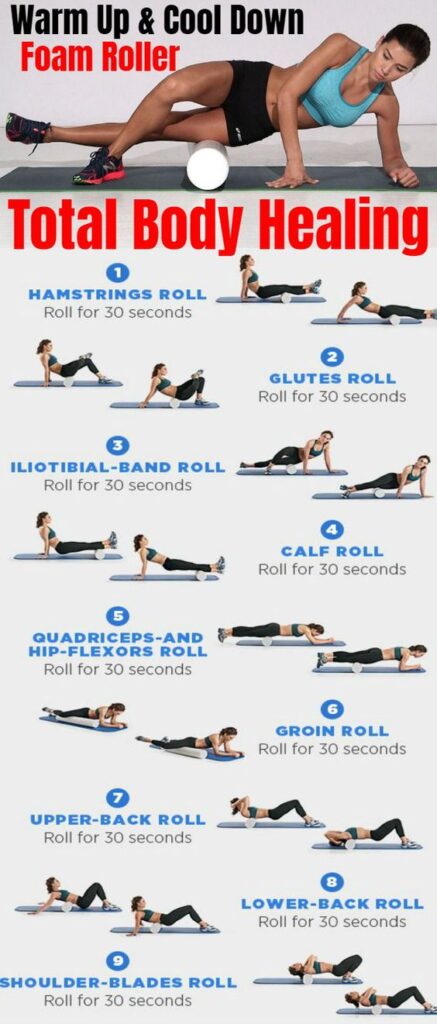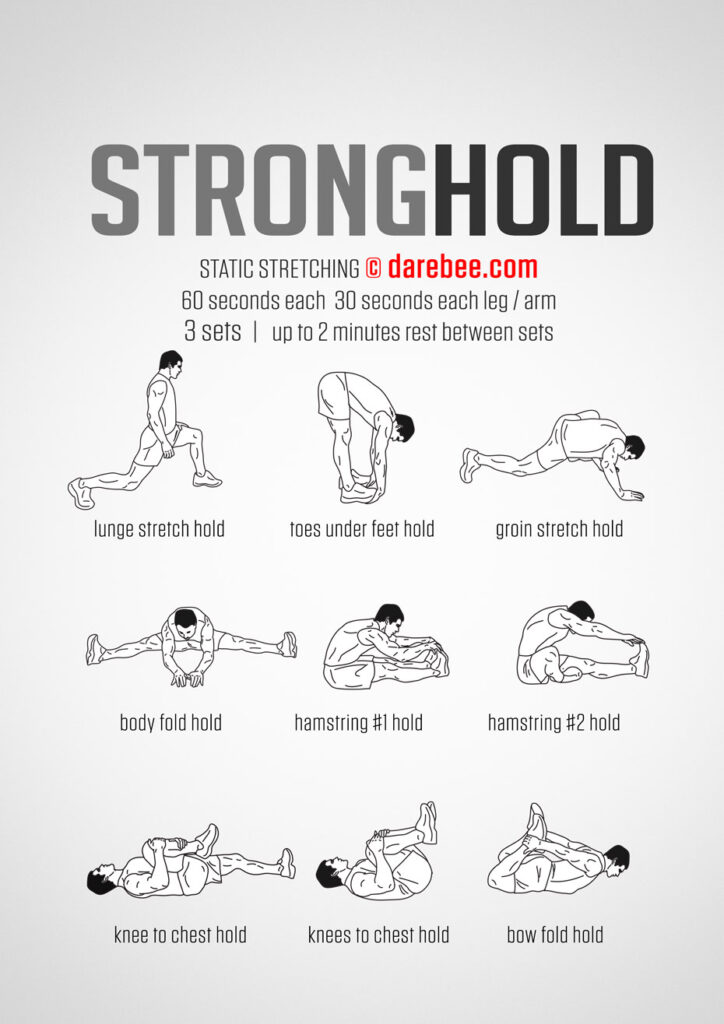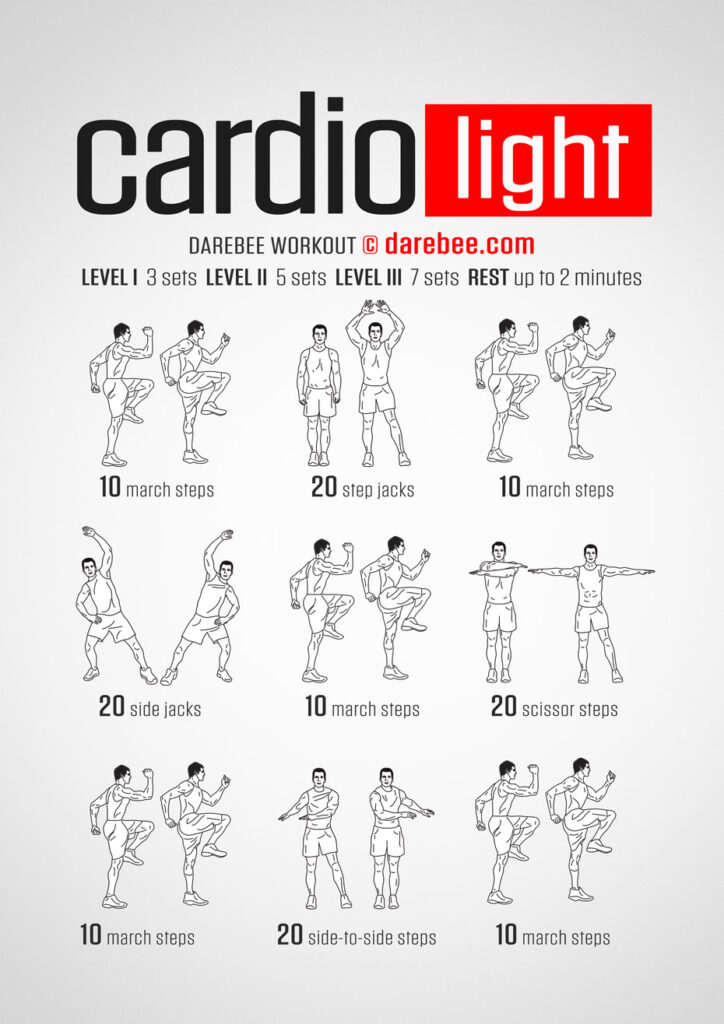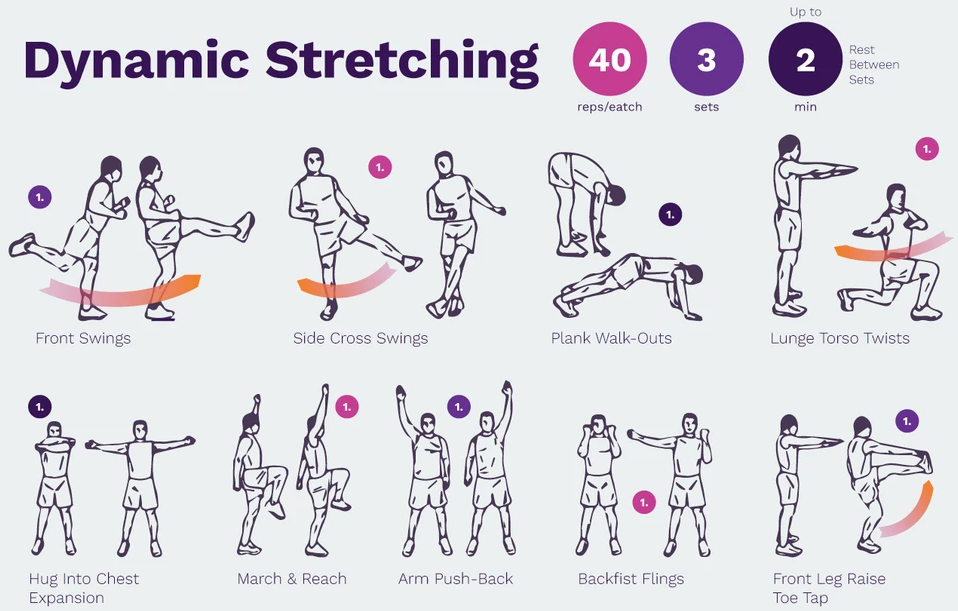Warm up is a must before any type of physical activity to prevent the chance for muscle and tendon injuries. Proper warm up increases the body’s core and muscle temperature. It improves the energy production rate, which increases reflexes and lowers the time it takes to contract a muscle. Warm up also enhances the range of motion and mentally prepares you for intense exercise. Additionally, warm-up helps the body to deliver oxygen to the exercising muscle groups.
Warm up stretches are also recommended before lifting weights. And if you don’t do dynamic or static warm up exercises before powerlifting, you will feel stiff hips, lack of muscular tension, poor coordination between different muscles, and weights will feel heavy as shit.
Although your warm-up should be specific to the type of exercise you are doing, the upper-body warm-up is required for weight training, yet a full-body warm-up is recommended. This article will guide you on how to warm up before lifting.
Common Warm Up Exercises:
Below is the list of some common warm up exercises that are used by coaches and athletes prior to their training sessions and competitive events to make them ready in 10 minutes for lifting weight. Fitness exports advice that back warm-up and arms warm-up are compulsory for lifting weights. Remember that not all exercises are performed by any coach/athlete or for any game.
Also Read: 10 Best Yoga Poses for Stress and Anxiety
Foam Rolling / Myofascial Release
A warm-up enhances the mechanical efficiency to exercise with heavyweights, but it all depends upon how you warm-up before lifting. Recently, foam rolling, also known as myofascial release, is getting so much popularity that in almost every health club or training studio, you are likely to see individuals lying on the floor rolling around on a tubular piece of foam. Foam rolling is a great way to reduce tension and increase muscle length during either the warm-up or cool-down phases of a workout.

Static Stretching
Warm-up stretches normally include static stretching and dynamic stretching. We will discuss dynamic stretching in the later part. However, static stretching is used as a gentle introduction to the training session and allow athletes to make a mental inventory of any tightness or muscles all stiffness headed into the session.
This type of stretching involves stretches in which you stand, sit or lie still and hold a single position for a period of time, up to about 45 seconds. This helps your muscles to loosen up while increasing flexibility and range of motion.
Also Read: How to Start Going to the Gym
Moreover, time a stretch is held is determined by your age, pre-existing conditions, activity level, and any injuries. You can do static stretching for a back warm-up and arms-warm-up along with doing for lower body and upper body warm up.

Light Cardiovascular Exercise
Many coaches guide how to warm up before lifting, and all they support light cardiovascular exercises like rowing, biking, skipping rope and jogging. They are capable of increasing the core body temperature and circulation throughout the body.
Usually, people do these warm-up exercises before a dynamic warm-up to allow an athlete to go into a dynamic warm-up already warm and prepared for the fast-paced movement series ahead. Doing these low-intensity exercises will let you go easier and be gentle on your body, your joints will thank you for this. However, this is a great way to get in a heart-pumping workout without worrying too much about injuries.

Dynamic Warm Up / Dynamic Stretching
This list of most utilitarian warm-up exercises includes dynamic stretching too. In a dynamic warm up exercise, you mimic movements that you will use consistently throughout the course to increase blood flow to the areas which will be working and to wake up the nervous system throughout the body.
Dynamic stretching does improve performance in your workout of lifting weights. Dynamic stretching is better than static stretching in unlocking mobility because it involves active movement and taking your body through ranges of motion that will better prepare you for your workout or sporting activity.

The Upshot
There is a wide array of warm-up methods an athlete can use to prepare for training sessions. If you wish to do lifting and don’t know how to warm-up before lifting, outfit yourself in comfortable workout clothes, bring all the accessories required for your workout in your workout bag to your gym, and use all of the above methods to prepare yourself in 10-15 minutes for your weight training.
Most Common FAQs about Warm-Up
Should I warm up before lifting weights?
Warming up before lifting weights is highly recommended because it will increase your flexibility, lubricate your joints, get you into the groove for exercise, and have optimal results. You will be able to exercise with heavy weights with less effort if you are warmed-up for your session.
What happens if you lift weights without warming up?
If you start weight lifting sessions without a proper warm-up, there is a great chance that you will incur an injury because your muscles will be tight and not ready for intense physical activity. Moreover, you will feel heavier than it is if your muscles and body are not heated before lifting.
Is running a good warm up?
Running is a good warm-up for the lower body and legs because it increases your heart rate and core temperature, but it has almost no involvement in warming up your upper body. If you wish to warm-up your body for a weight lifting session, you should do a full-body warm-up.
What is the best warm up before a workout?
Which warm-up is best for you depends entirely on which workout you want to do after being warmed-up. Different warm-ups are recommended for different workouts. Although you should do a full-body warm-up, yet the muscles you will use in exercising are the ones you should take extra care of while warming up.
Is it OK to stretch without warming up?
Although a brief warm up is also recommended before dynamic stretching because it will increase the viscoelasticity of your muscles, which will allow for greater ROM during your dynamic workout, yet static stretching without a warm-up is both dangerous and not beneficial. When you are dynamic stretching, you are stretching and warming up at the same time, and in case of static stretching, you are putting pressure on muscles that are not charged for the intensity of static stretching.
What happens if you don’t warm up before a workout?
Warm-up is crucial because it gets your body ready for activity by heating up muscle tissue, improving tissue extensibility, decreasing internal tissue resistance, and increasing the amount of tissue deformation. Without proper warm-up, you not only break the threshold into injury, but you also get less from your workout. Your muscles will not have received nutrient-rich oxygenated blood before your workout, and you will feel tired very quickly.
Can I warm up at home before the gym?
It’s better to do a warm-up in a gym, but still, you can warm up at home so long as you get to the gym quickly and remain suitably warm during the trip. As a general rule of thumb, you should start your exercise routine at least ten minutes after a good warm-up.

Ashley Aston is a specialized fitness instructor who first joined the gym as a trainee to get in the right shape. On achieving fitness goals, she became a fitness fanatic and chose this as a professional career at Born Tough. Although she is a mother with tons of responsibilities at home, she still manages to work hard and excel in her fitness career. She is a staunch believer of being fit despite any age, gender, or profession.
